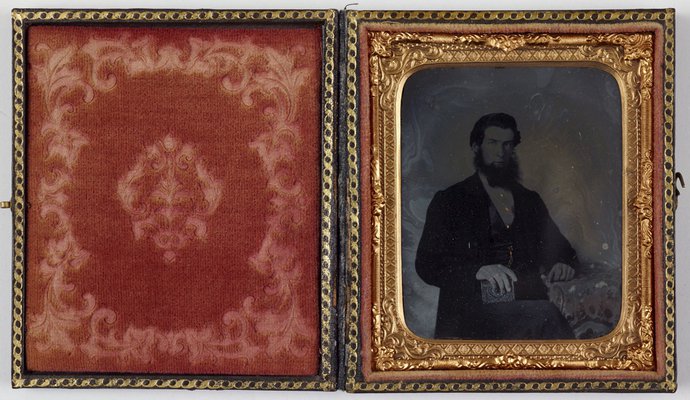Title
Untitled (unknown man with dark hair and beard, gold watch chain, rings and shirt studs, holding an ambrotype? with Ottoman embroidered table cloth)
1860s
Artist


-
Details
- Date
- 1860s
- Media category
- Photograph
- Materials used
- ambrotype, cased
- Edition
- unique
- Dimensions
- 6.7 x 5.3 cm image; 9.4 x 8 x 0.8 cm case closed; 9.4 x 16.2 x 0.7 cm case open
- Signature & date
Not signed. Not dated.
- Credit
- Gift of Dr Paul Fox in memory of Jennifer Phipps (1944-2014) 2015
- Location
- Not on display
- Accession number
- 425.2015
- Copyright
- Artist information
-
Unknown
Works in the collection
- Share
-
-
About
The ambrotype was invented in 1851, eventually superseding the daguerreotype. An ambrotype is a photographic impression made on glass and is unique. The process was difficult and the chemicals dangerous; a glass plate covered in iodized collodion solution was dipped in silver nitrate and exposed while wet. This process was faster and more cost effective than the production of the daguerreotype. The negative impression of the ambrotype was then mounted onto an opaque substance or material in order to create a positive image. Due to the fragility of the materials ambrotypes were usually stored in cases.
This ambrotype by an unknown photographer is of a man possibly of Greek or Armenian descent and highlights the transnational nature of the technology. The table cloth in the image appears to carry an Ottoman design. The easily recognisable pose of the sitter is indicative of the way photography and pictorial codes cross regional divides. The sitter is holding what appears to be another ambrotype or its case. The rise and spread of the ambrotype was paralleled only by its decline: superseded in popularity by the tintype in the 1860s.
